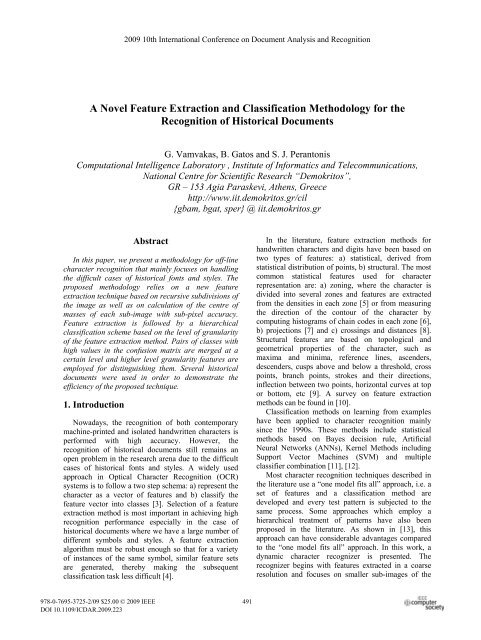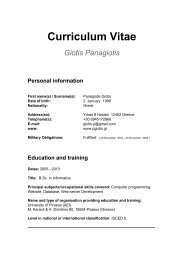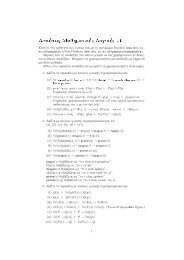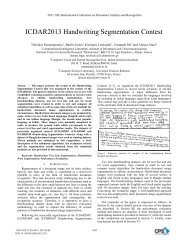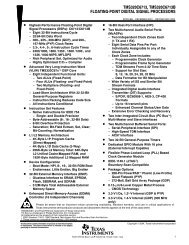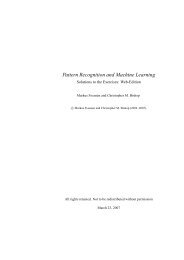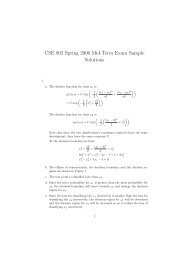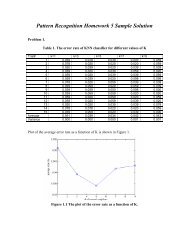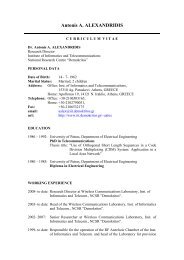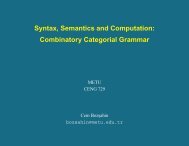A Novel Feature Extraction and Classification Methodology for the ...
A Novel Feature Extraction and Classification Methodology for the ...
A Novel Feature Extraction and Classification Methodology for the ...
Create successful ePaper yourself
Turn your PDF publications into a flip-book with our unique Google optimized e-Paper software.
2009 10th International Conference on Document Analysis <strong>and</strong> Recognition<br />
A <strong>Novel</strong> <strong>Feature</strong> <strong>Extraction</strong> <strong>and</strong> <strong>Classification</strong> <strong>Methodology</strong> <strong>for</strong> <strong>the</strong><br />
Recognition of Historical Documents<br />
G. Vamvakas, B. Gatos <strong>and</strong> S. J. Perantonis<br />
Computational Intelligence Laboratory , Institute of In<strong>for</strong>matics <strong>and</strong> Telecommunications,<br />
National Centre <strong>for</strong> Scientific Research “Demokritos”,<br />
GR – 153 Agia Paraskevi, A<strong>the</strong>ns, Greece<br />
http://www.iit.demokritos.gr/cil<br />
{gbam, bgat, sper} @ iit.demokritos.gr<br />
Abstract<br />
In this paper, we present a methodology <strong>for</strong> off-line<br />
character recognition that mainly focuses on h<strong>and</strong>ling<br />
<strong>the</strong> difficult cases of historical fonts <strong>and</strong> styles. The<br />
proposed methodology relies on a new feature<br />
extraction technique based on recursive subdivisions of<br />
<strong>the</strong> image as well as on calculation of <strong>the</strong> centre of<br />
masses of each sub-image with sub-pixel accuracy.<br />
<strong>Feature</strong> extraction is followed by a hierarchical<br />
classification scheme based on <strong>the</strong> level of granularity<br />
of <strong>the</strong> feature extraction method. Pairs of classes with<br />
high values in <strong>the</strong> confusion matrix are merged at a<br />
certain level <strong>and</strong> higher level granularity features are<br />
employed <strong>for</strong> distinguishing <strong>the</strong>m. Several historical<br />
documents were used in order to demonstrate <strong>the</strong><br />
efficiency of <strong>the</strong> proposed technique.<br />
1. Introduction<br />
Nowadays, <strong>the</strong> recognition of both contemporary<br />
machine-printed <strong>and</strong> isolated h<strong>and</strong>written characters is<br />
per<strong>for</strong>med with high accuracy. However, <strong>the</strong><br />
recognition of historical documents still remains an<br />
open problem in <strong>the</strong> research arena due to <strong>the</strong> difficult<br />
cases of historical fonts <strong>and</strong> styles. A widely used<br />
approach in Optical Character Recognition (OCR)<br />
systems is to follow a two step schema: a) represent <strong>the</strong><br />
character as a vector of features <strong>and</strong> b) classify <strong>the</strong><br />
feature vector into classes [3]. Selection of a feature<br />
extraction method is most important in achieving high<br />
recognition per<strong>for</strong>mance especially in <strong>the</strong> case of<br />
historical documents where we have a large number of<br />
different symbols <strong>and</strong> styles. A feature extraction<br />
algorithm must be robust enough so that <strong>for</strong> a variety<br />
of instances of <strong>the</strong> same symbol, similar feature sets<br />
are generated, <strong>the</strong>reby making <strong>the</strong> subsequent<br />
classification task less difficult [4].<br />
In <strong>the</strong> literature, feature extraction methods <strong>for</strong><br />
h<strong>and</strong>written characters <strong>and</strong> digits have been based on<br />
two types of features: a) statistical, derived from<br />
statistical distribution of points, b) structural. The most<br />
common statistical features used <strong>for</strong> character<br />
representation are: a) zoning, where <strong>the</strong> character is<br />
divided into several zones <strong>and</strong> features are extracted<br />
from <strong>the</strong> densities in each zone [5] or from measuring<br />
<strong>the</strong> direction of <strong>the</strong> contour of <strong>the</strong> character by<br />
computing histograms of chain codes in each zone [6],<br />
b) projections [7] <strong>and</strong> c) crossings <strong>and</strong> distances [8].<br />
Structural features are based on topological <strong>and</strong><br />
geometrical properties of <strong>the</strong> character, such as<br />
maxima <strong>and</strong> minima, reference lines, ascenders,<br />
descenders, cusps above <strong>and</strong> below a threshold, cross<br />
points, branch points, strokes <strong>and</strong> <strong>the</strong>ir directions,<br />
inflection between two points, horizontal curves at top<br />
or bottom, etc [9]. A survey on feature extraction<br />
methods can be found in [10].<br />
<strong>Classification</strong> methods on learning from examples<br />
have been applied to character recognition mainly<br />
since <strong>the</strong> 1990s. These methods include statistical<br />
methods based on Bayes decision rule, Artificial<br />
Neural Networks (ANNs), Kernel Methods including<br />
Support Vector Machines (SVM) <strong>and</strong> multiple<br />
classifier combination [11], [12].<br />
Most character recognition techniques described in<br />
<strong>the</strong> literature use a “one model fits all” approach, i.e. a<br />
set of features <strong>and</strong> a classification method are<br />
developed <strong>and</strong> every test pattern is subjected to <strong>the</strong><br />
same process. Some approaches which employ a<br />
hierarchical treatment of patterns have also been<br />
proposed in <strong>the</strong> literature. As shown in [13], this<br />
approach can have considerable advantages compared<br />
to <strong>the</strong> “one model fits all” approach. In this work, a<br />
dynamic character recognizer is presented. The<br />
recognizer begins with features extracted in a coarse<br />
resolution <strong>and</strong> focuses on smaller sub-images of <strong>the</strong><br />
978-0-7695-3725-2/09 $25.00 © 2009 IEEE<br />
DOI 10.1109/ICDAR.2009.223<br />
491
character on each recursive pass, thus working with a<br />
finer resolution of a sub-image each time, till<br />
classification meets acceptance criteria.<br />
In this paper we present a novel feature extraction<br />
method based on recursive subdivisions of <strong>the</strong><br />
character image as well as on calculation of <strong>the</strong> centre<br />
of masses of each sub-image with sub-pixel accuracy.<br />
This feature extraction scheme represents <strong>the</strong><br />
characters at different levels of granularity. Even<br />
though <strong>the</strong> method is quite efficient when a specific<br />
level of granularity is used, we show that more is to be<br />
gained in classification accuracy by exploiting <strong>the</strong><br />
intrinsically recursive nature of <strong>the</strong> method. This is<br />
achieved by appropriately combining <strong>the</strong> results from<br />
different levels using a hierarchical approach. Lower<br />
levels are used to per<strong>for</strong>m a preliminary<br />
discrimination, whereas higher levels help in<br />
distinguishing between characters of similar shapes<br />
that are confused when using only lower levels. The<br />
remaining of this paper is organized as follows. In<br />
Section 2 <strong>the</strong> proposed OCR methodology is presented<br />
while experimental results are discussed in Section 3.<br />
Finally, conclusions are drawn in Section 4.<br />
2. OCR <strong>Methodology</strong><br />
The proposed OCR methodology follows a two step<br />
schema: First a feature extraction method is applied to<br />
obtain <strong>the</strong> feature vectors <strong>and</strong> <strong>the</strong>n a hierarchical<br />
classification scheme is per<strong>for</strong>med.<br />
2.1. <strong>Feature</strong> <strong>Extraction</strong><br />
In this session a new feature extraction method, <strong>for</strong><br />
<strong>the</strong> recognition of machine printed <strong>and</strong> h<strong>and</strong>written<br />
historical documents, is presented. This method is<br />
based on structural features, extracted directly from <strong>the</strong><br />
character image that provide a good representation of<br />
<strong>the</strong> character at different levels of granularity <strong>and</strong><br />
permit h<strong>and</strong>ling <strong>the</strong> difficult cases of historical fonts<br />
<strong>and</strong> styles.<br />
Let im(x,y) be <strong>the</strong> character image array having 1s<br />
<strong>for</strong> <strong>for</strong>eground <strong>and</strong> 0s <strong>for</strong> background pixels <strong>and</strong> x max<br />
<strong>and</strong> y max be <strong>the</strong> width <strong>and</strong> <strong>the</strong> height of <strong>the</strong> character<br />
image. Our feature extraction method relies on<br />
recursive sub-divisions of <strong>the</strong> character image based on<br />
<strong>the</strong> centre of mass of each sub-image. In order to avoid<br />
quantizing errors <strong>and</strong> improve <strong>the</strong> precision, <strong>the</strong><br />
centres of masses are calculated with sub-pixel<br />
accuracy. First, <strong>the</strong> co-ordinates (x o , y o ) of <strong>the</strong> centre of<br />
mass of <strong>the</strong> initial character image are calculated. The<br />
vertical co-ordinate x 0 is found according to <strong>the</strong><br />
following procedure:<br />
Step 1: Let V o be <strong>the</strong> vertical projection array of <strong>the</strong><br />
initial character image.<br />
Step 2: Create V 1 array from V 0 as follows:<br />
<strong>for</strong> x = 1 to 2 * x max<br />
if x mod 2 = 1 <strong>the</strong>n<br />
V 1 [x] = 0<br />
else<br />
V 1 [x] = V 0 [x div 2 ]<br />
end if<br />
end <strong>for</strong><br />
Step 3: Find x q from V 1 using <strong>the</strong> following equation:<br />
⎪<br />
⎧x=<br />
xt<br />
−1<br />
x=<br />
2* xmax<br />
⎪<br />
⎫<br />
x q = argmin⎨<br />
∑V1 ( x)<br />
− ∑V1<br />
( x)<br />
⎬ (1)<br />
xt<br />
⎪⎩ x=<br />
1 x=<br />
xt<br />
+ 1 ⎪⎭<br />
Step 4: The vertical co-ordinate x 0 is <strong>the</strong>n estimated as:<br />
xo = xqdiv2<br />
(2)<br />
As already mentioned, in order to improve <strong>the</strong><br />
precision, <strong>the</strong> centre of mass <strong>for</strong> each of <strong>the</strong> following<br />
sub-images is calculated with sub-pixel accuracy. That<br />
is, <strong>the</strong> initial image is divided vertically into two<br />
rectangular sub-images depending on <strong>the</strong> value of x q<br />
(Eq 1). If x q mod 2 = 0 <strong>the</strong>n <strong>the</strong> vertex co-ordinates of<br />
<strong>the</strong>se two sub-images are: {(1, 1), (x 0 , y max )} <strong>and</strong> {(x 0 ,<br />
1), (x max , y max )}. O<strong>the</strong>rwise, if x q mod 2 = 1, <strong>the</strong>n <strong>the</strong><br />
vertex co-ordinates are: {(1, 1), (x 0 , y max )} <strong>and</strong> {(x 0 +1,<br />
1), (x max , y max )}.<br />
Likewise, <strong>the</strong> horizontal co-ordinate y 0 is calculated<br />
thus resulting to <strong>the</strong> division of <strong>the</strong> initial character<br />
images into four rectangular sub-images. The whole<br />
procedure is applied recursively <strong>for</strong> every sub-image<br />
(Fig.1).<br />
(a)<br />
(b) (c) (d) (e)<br />
Figure 1. Character image <strong>and</strong> sub-images based on<br />
centre of mass: (a) original image, (b), (c), (d), (e)<br />
subdivisions at levels 0, 1, 2 <strong>and</strong> 3 respectively.<br />
Let L be <strong>the</strong> current level of <strong>the</strong> granularity. At this<br />
level <strong>the</strong> number of <strong>the</strong> sub-images is 4 (L+1) . For<br />
example, when L=0 (Fig.1b) <strong>the</strong> number of sub-images<br />
is 4 <strong>and</strong> when L=1 it is 16 (Fig.1c). The number of <strong>the</strong><br />
center of masses at level L equals to 4 L (Fig.2). At level<br />
L, <strong>the</strong> co-ordinates (x, y) of all <strong>the</strong> centre of masses are<br />
492
stored as features. So, <strong>for</strong> every L a 2*4 L - dimensional<br />
feature vector is extracted. As Fig.2 shows, <strong>the</strong> larger<br />
<strong>the</strong> L <strong>the</strong> better representation of <strong>the</strong> character is<br />
obtained. Up to here two questions rise as one can<br />
easily realize. First, at which level L of granularity <strong>the</strong><br />
best recognition result is achieved <strong>and</strong> second, how<br />
deep <strong>the</strong> penetration will be. Both questions are<br />
answered at <strong>the</strong> following section of <strong>the</strong> paper.<br />
(a) (b) (c)<br />
classification procedure. Confusion matrices are<br />
created at each level from <strong>the</strong> training set using a K-<br />
fold cross-validation process. In K-fold crossvalidation,<br />
<strong>the</strong> original training set is partitioned into K<br />
subsets. Of <strong>the</strong> K subsets, a single subset is retained as<br />
<strong>the</strong> validation data <strong>for</strong> testing <strong>the</strong> model, <strong>and</strong> <strong>the</strong><br />
remaining K−1 subsets are used as training data. The<br />
cross-validation process is <strong>the</strong>n repeated K times (<strong>the</strong><br />
folds), with each of <strong>the</strong> K subsets used exactly once as<br />
<strong>the</strong> validation data. The K results from <strong>the</strong> folds <strong>the</strong>n<br />
can be averaged (or o<strong>the</strong>rwise combined) to produce a<br />
single estimation. The advantage of this method over<br />
repeated r<strong>and</strong>om sub-sampling is that all observations<br />
are used <strong>for</strong> both training <strong>and</strong> validation, <strong>and</strong> each<br />
observation is used <strong>for</strong> validation exactly once. In our<br />
case K is set to 10.<br />
(d) (e) (f)<br />
Figure 2. <strong>Feature</strong>s based on centre of mass: (a)<br />
original image, (b), (c), (d), (e), (f) features at levels<br />
0, 1, 2, 3 <strong>and</strong> 4 respectively.<br />
After all feature vectors are extracted each<br />
feature is normalized to [0, 1]. Let m i be <strong>the</strong> mean<br />
value of <strong>the</strong> i th feature <strong>for</strong> all training vectors <strong>and</strong> σ i<br />
<strong>the</strong> st<strong>and</strong>ard deviation respectively. Then <strong>the</strong> value<br />
f i of <strong>the</strong> i th feature of every feature vector is<br />
normalized according to Eq.3.<br />
( f<br />
i<br />
− mi<br />
)<br />
+ 1<br />
'<br />
3σ<br />
ι<br />
f<br />
i<br />
= (3)<br />
2<br />
2.2. Hierarchical <strong>Classification</strong><br />
For <strong>the</strong> recognition stage a hierarchical<br />
classification scheme is employed. Since characters<br />
with similar structure i.e. ‘ζ’ <strong>and</strong> ‘ξ’ from <strong>the</strong> Greek<br />
alphabet, are often mutually confused when using a<br />
low granularity feature representation, we propose to<br />
merge <strong>the</strong> corresponding classes to <strong>the</strong> certain level of<br />
classification. At a next step, we distinguish those<br />
character classes by employing a higher granularity<br />
feature extraction vector at a hierarchical classification<br />
scheme. The hierarchical classification scheme has<br />
four distinct steps; three <strong>for</strong> training phase <strong>and</strong> one <strong>for</strong><br />
testing.<br />
Step 1: Starting from level 1 <strong>and</strong> gradually<br />
proceeding to higher levels of granularity features are<br />
extracted, <strong>the</strong> confusion matrix is created <strong>and</strong> <strong>the</strong><br />
overall recognition rate is calculated, until <strong>the</strong><br />
recognition rate stops increasing (Fig.3). <strong>Feature</strong>s from<br />
level L with <strong>the</strong> highest recognition rate (Max_RR) are<br />
considered to be <strong>the</strong> initial features used <strong>for</strong> <strong>the</strong><br />
Figure 3. Example of finding <strong>the</strong> Level L of granularity<br />
with <strong>the</strong> highest recognition rate.<br />
Step 2: Let <strong>the</strong> overall recognition rate among all<br />
categories <strong>for</strong> <strong>the</strong> best per<strong>for</strong>ming level L of<br />
granularity, that is Max_RR, be a threshold. At this<br />
level L, <strong>the</strong> corresponding confusion matrix is scanned<br />
<strong>and</strong> classes whose recognition rate is below this<br />
threshold are detected. For each one of <strong>the</strong>se classes<br />
find <strong>the</strong> class with which <strong>the</strong>y are mutually<br />
misclassified <strong>the</strong> most <strong>and</strong> consider <strong>the</strong>m to be one<br />
pair.<br />
Step 3: For each one of <strong>the</strong> pair classes found in<br />
Step 2 ano<strong>the</strong>r classifier is trained with features<br />
extracted at level L + 1 of <strong>the</strong> granularity procedure in<br />
order to distinguish <strong>the</strong>m at a later stage of <strong>the</strong><br />
classification.<br />
Step 4: Each pattern of <strong>the</strong> test set is <strong>the</strong>n fed to <strong>the</strong><br />
initial classifier with features extracted at level L. If <strong>the</strong><br />
classifier decides that this pattern belongs to one of <strong>the</strong><br />
non-pair classes <strong>the</strong>n its decision is taken into account<br />
<strong>and</strong> <strong>the</strong> unknown pattern is assumed to be classified.<br />
Else, if it is classified to one of <strong>the</strong> pair classes <strong>the</strong>n it<br />
is given to <strong>the</strong> pair’s corresponding classifier <strong>and</strong> this<br />
new classifier decides <strong>the</strong> recognition result.<br />
3. Experimental Results<br />
For our experiments two databases comprising<br />
samples of characters from old Greek Christian<br />
documents of <strong>the</strong> 17 th century <strong>and</strong> <strong>the</strong> CEDAR CD-<br />
493
ROM1 [1] database were used. In <strong>the</strong> particular<br />
classification problem, classification step was<br />
per<strong>for</strong>med using SVM [14] with Radial Basis Function<br />
(RBF).<br />
In [15] two databases using a clustering scheme,<br />
are created from old Greek Christian documents. A<br />
typewritten (TW) consisting of 13,966 characters from<br />
67 classes <strong>and</strong> a h<strong>and</strong>written (HW) one of 6,758<br />
characters from 51 classes. Moreover <strong>for</strong> both<br />
databases, <strong>the</strong> 80% of each class is used <strong>for</strong> training<br />
while <strong>the</strong> rest 20% is used <strong>for</strong> testing (Table 1).<br />
Table 1. The historical typewritten (TW) <strong>and</strong><br />
h<strong>and</strong>written (HW) databases.<br />
Database<br />
Data<br />
Set<br />
Number<br />
of Classes<br />
Train<br />
Set<br />
Test<br />
Set<br />
TW 13,966 67 11,173 2,793<br />
HW 6,758 51 5,407 1,351<br />
The CEDAR database consists of samples of 52<br />
English h<strong>and</strong>written characters: 19,145 characters were<br />
used <strong>for</strong> training <strong>and</strong> 2,183 characters <strong>for</strong> testing.<br />
For all three databases each character is normalized<br />
to an NxN matrix. In our case, N = 60.<br />
According to Section 2, <strong>the</strong> best per<strong>for</strong>ming level is<br />
first found. As shown in Table 2, <strong>for</strong> <strong>the</strong> TW-Database<br />
<strong>the</strong> best per<strong>for</strong>ming level (97.59%) is 2. Then, <strong>the</strong><br />
confusion matrix at level 2 is scanned <strong>and</strong> <strong>for</strong> every<br />
class whose recognition rate is below 97.59% <strong>the</strong> class<br />
with which it is mutually misclassified <strong>the</strong> most is<br />
detected. Table 3 shows <strong>the</strong> most confused pairs of<br />
classes. Each pair is merged into one class <strong>and</strong> <strong>for</strong><br />
every pair a new SVM is trained with features from<br />
level 3 in order to distinguish <strong>the</strong>m at a next stage.<br />
Table 2 depicts <strong>the</strong> recognition rates achieved at each<br />
level <strong>and</strong> <strong>the</strong> recognition rate using <strong>the</strong> hierarchical<br />
classification procedure.<br />
Table 2. Recognition rates using <strong>the</strong> TW-Database.<br />
TW - Database<br />
Level 1 91.46%<br />
Level 2 97.59%<br />
Level 3 95.55%<br />
Hierarchical <strong>Classification</strong> 97.71 %<br />
Table 3. Mutually misclassified classes <strong>for</strong> features<br />
at level 2 <strong>for</strong> <strong>the</strong> TW - Database.<br />
Class 1 Class 2<br />
α<br />
ο<br />
ς<br />
(στ)<br />
ν<br />
υ<br />
τ<br />
Τ<br />
Α<br />
Λ<br />
For <strong>the</strong> HW-Database, <strong>the</strong> highest recognition rate<br />
(93.14%) is achieved when features from level 3 are<br />
used (Table 4), mutually misclassified classes at this<br />
level are found (Table 5) <strong>and</strong> again <strong>the</strong> overall<br />
recognition rate is improved when <strong>the</strong> hierarchical<br />
classification scheme is applied.<br />
Table 4. Recognition rates using <strong>the</strong> HW-Database.<br />
HW - Database<br />
Level 1 81.50%<br />
Level 2 91.96%<br />
Level 3 93.14%<br />
Level 4 89.31%<br />
Hierarchical <strong>Classification</strong> 94.51 %<br />
Table 5. Mutually misclassified classes <strong>for</strong> features<br />
at level 3 <strong>for</strong> <strong>the</strong> HW - Database.<br />
Class 1 Class 2<br />
κ<br />
(και)<br />
α<br />
ο<br />
ρ<br />
φ<br />
ε<br />
Σ<br />
In [15], an evaluation of <strong>the</strong>se two databases is also<br />
presented. In order to do so, a hybrid feature extraction<br />
scheme is employed based on zones <strong>and</strong> projections<br />
combined in a fusion way. The comparison of this<br />
methodology with <strong>the</strong> one proposed in this paper is<br />
shown in Table 6. From this table, it is evident that<br />
although <strong>the</strong> recognition rate is almost <strong>the</strong> same as far<br />
as <strong>the</strong> h<strong>and</strong>written database is concerned, when it<br />
comes to typewritten characters <strong>the</strong> improvement is<br />
considerably noticeable.<br />
Table 6. Comparison of <strong>the</strong> proposed OCR<br />
methodology <strong>for</strong> historical characters.<br />
TW-Database HW-Database<br />
Hybrid [15] 95.44% 94.62%<br />
Proposed<br />
<strong>Methodology</strong><br />
97.71% 94.51%<br />
Finally, Tables 7 depicts <strong>the</strong> recognition results of<br />
<strong>the</strong> proposed methodology when applied to modern<br />
characters as well. As mentioned be<strong>for</strong>e, <strong>for</strong> this<br />
experiment <strong>the</strong> CEDAR database was used, trying to<br />
distinguish all 52 characters (classes). Table 8 shows<br />
<strong>the</strong> comparison with o<strong>the</strong>r state-of-<strong>the</strong>-art techniques<br />
that deal with 52 classes.<br />
4. Conclusions<br />
In this paper a new feature extraction method, <strong>for</strong><br />
historical machine printed <strong>and</strong> h<strong>and</strong>written characters,<br />
was presented based on recursive subdivisions of <strong>the</strong><br />
494
character image. As shown at <strong>the</strong> experimental results,<br />
<strong>the</strong> proposed hierarchical classification scheme<br />
outper<strong>for</strong>ms o<strong>the</strong>r state-of-<strong>the</strong>-art feature extraction<br />
techniques as far as recognition of historical fonts <strong>and</strong><br />
styles is concerned while works efficiently enough <strong>for</strong><br />
contemporary h<strong>and</strong>written documents.<br />
Table 7. Recognition rates using <strong>the</strong> CEDAR<br />
Database.<br />
CEDAR Database<br />
Level 1 56.57%<br />
Level 2 77.28%<br />
Level 3 77.51%<br />
Level 4 75.36%<br />
Hierarchical <strong>Classification</strong> 80.19%<br />
Table 8. Comparison of <strong>the</strong> proposed OCR<br />
methodology <strong>for</strong> modern characters.<br />
CEDAR Database<br />
Yamada [16] 75.70%<br />
Kimura [17] 73.25%<br />
Gader [18] 74.77%<br />
Proposed <strong>Methodology</strong> 80.19%<br />
5. Acknowledgement<br />
The research leading to <strong>the</strong>se results has received<br />
funding from <strong>the</strong> European Community's Seventh<br />
Framework Programme under grant agreement n°<br />
215064 (project IMPACT).<br />
6. References<br />
[1] J.J. Hull, “A database <strong>for</strong> h<strong>and</strong>written text recognition<br />
research”, IEEE Trans. Pattern Anal. Mach. Intell. 16 (5)<br />
(1994) 550–554.<br />
[2] The MNIST Database, http://yann.lecun.com/exdb/mnist/<br />
[3] A. S. Brito, R. Sabourin, F. Bortolozzi, “Foreground <strong>and</strong><br />
Background In<strong>for</strong>mation in a HMM-Based Method <strong>for</strong><br />
Recognition of Isolated Characters <strong>and</strong> Numeral Strings”,<br />
Proceedings of <strong>the</strong> 9th International Workshop on Frontiers<br />
in H<strong>and</strong>written Recognition, 2004, pp. 371-376.<br />
[4] J. A. Fitzgerald, F. Geiselbrechtinger, <strong>and</strong> T. Kechadi,<br />
“Application of Fuzzy Logic to Online Recognition of<br />
H<strong>and</strong>written Symbols”, Proceedings of <strong>the</strong> 9th International<br />
Workshop on Frontiers in H<strong>and</strong>written Recognition, 2004,<br />
pp. 395-400.<br />
[5] Luiz S. Oliveira, F. Bortolozzi, C.Y.Suen, “Automatic<br />
Recognition of H<strong>and</strong>written Numerical Strings: A<br />
Recognition <strong>and</strong> Verification Strategy”, IEEE Transactions<br />
on Pattern Recognition <strong>and</strong> Machine Intelligence, 2001, Vol.<br />
24, No. 11, pp. 1448-1456.<br />
[6] K. M. Mohiuddin <strong>and</strong> J. Mao, “A Comprehensive Study<br />
of Different Classifiers <strong>for</strong> H<strong>and</strong>printed Character<br />
Recognition”, Pattern Recognition, Practice IV, 1994, pp.<br />
437- 448.<br />
[7] A. L. Koerich, “Unconstrained H<strong>and</strong>written Character<br />
Recognition Using Different <strong>Classification</strong> Strategies”,<br />
International Workshop on Artificial Neural Networks in<br />
Pattern Recognition (ANNPR), 2003.<br />
[8] J. H. Kim, K. K. Kim, C. Y. Suen, “Hybrid Schemes Of<br />
Homogeneous <strong>and</strong> Heterogeneous Classifiers <strong>for</strong> Cursive<br />
Word Recognition”, Proceedings of <strong>the</strong> 7th International<br />
Workshop on Frontiers in H<strong>and</strong>written Recognition,<br />
Amsterdam, 2000, pp 433 - 442.<br />
[9] N. Arica <strong>and</strong> F. Yarman-Vural, “An Overview of<br />
Character Recognition Focused on Off-line H<strong>and</strong>writing”,<br />
IEEE Transactions on Systems, Man, <strong>and</strong> Cybernetics, Part<br />
C: Applications <strong>and</strong> Reviews, 2001, 31(2), pp. 216 - 233.<br />
[10] O. D. Trier, A. K. Jain, T.Taxt, “<strong>Feature</strong> <strong>Extraction</strong><br />
Methods <strong>for</strong> Character Recognition – A Survey”, Pattern<br />
Recognition, 1996, Vol.29, No.4, pp. 641-662.<br />
[11] C. L. Liu, H. Fujisawa, “<strong>Classification</strong> <strong>and</strong> Learning <strong>for</strong><br />
Character Recognition: Comparison of Methods <strong>and</strong><br />
Remaining Problems”, Int. Workshop on Neural Networks<br />
<strong>and</strong> Learning in Document Analysis <strong>and</strong> Recognition, Seoul,<br />
2005.<br />
[12] F. Bortolozzi, A. S. Brito, Luiz S. Oliveira <strong>and</strong> M.<br />
Morita, “Recent Advances in H<strong>and</strong>written Recognition”,<br />
Document Analysis, Umapada Pal, Swapan K. Parui, Bidyut<br />
B. Chaudhuri, pp 1-30.<br />
[13] J. Park, V. Govindaraju, S. N. Shrihari, “OCR in<br />
Hierarchical <strong>Feature</strong> Space”, IEEE Transactions on Pattern<br />
Analysis <strong>and</strong> Machine Intelligence, 2000, Vol. 22, No. 24,<br />
pp. 400-408.<br />
[14] Cortes C., <strong>and</strong> Vapnik, V, “Support-vector network”,<br />
Machine Learning, vol. 20, pp. 273-297, 1997.<br />
[15] G. Vamvakas, B. Gatos, N. Stamatopoulos <strong>and</strong><br />
S.J.Pernantonis, “A Complete Optical Character Recognition<br />
<strong>Methodology</strong> <strong>for</strong> Historical Documents”, Document Abalysis<br />
Systems (DAS’08), Nara, Japan, 2008, pp.525-532.<br />
[16] H. Yamada <strong>and</strong> Y. Nakano, “Cursive H<strong>and</strong>written Word<br />
Recognition Using Multiple Segmentation Determined by<br />
Contour Analysis”, IECIE Transactions on In<strong>for</strong>mation <strong>and</strong><br />
System, Vol. E79-D. pp. 464-470, 1996.<br />
[17] F. Kimura. N. Kayahara. Y. Miyake <strong>and</strong> M. Shridhar,<br />
"Machine <strong>and</strong> Human Recognition of Segmented Characters<br />
from H<strong>and</strong>written Words", International Conference on<br />
Document Analysis <strong>and</strong> Recognition (ICDAR '97), Ulm,<br />
Germany, 1997, pp. 866-869.<br />
[18]. P. D. Gader, M. Mohamed <strong>and</strong> J-H. Chiang.<br />
"H<strong>and</strong>written Word Recognition with Character <strong>and</strong> Inter-<br />
Character Neural Networks", IEEE Transactions on System,<br />
Man. <strong>and</strong> Cybernetics-Part B: Cybernetics, Vol. 27, 1997,<br />
pp. 158-164.<br />
495


